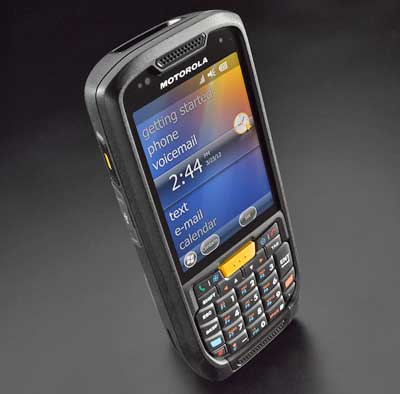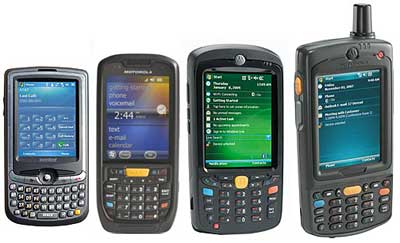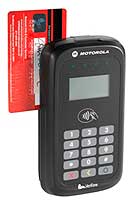|
Zebra MC45 Mobile Computer
Multi-function handheld for enterprise and field mobility applications
(by Conrad H. Blickenstorfer)
On January 29, 2013, the enterprise division of Motorola Solutions, which is now part of Zebra, introduced the MC45 mobile computer. The company described it as a cost- and size-optimized device targeted at applications such as customer relationship management (CRM), sales order entry, inventory management, proof of delivery, direct store delivery (DSD) and route accounting, while also expanding the range of solutions available for small- and medium-sized businesses and emerging markets. The MC45 combines a cell phone, mobile broadband, a laser scanner, an autofocus camera, and a mobile computer all into one small and handy device.

At the time of the MC45 release, Motorola Solutions' lineup of handheld computers included over 20 different products of varying ruggedness, size and design (and that was before all the Psion handhelds that were also under Motorola's jurisdiction). The majority used either the longish "flashlight" or the thumbtype PDA formfactor. So where did the MC45 fit into this crowded lineup? In general, a two-digit model numbers indicates an EDA or Enterprise Digital Assistant. Below you can see part of the EDA lineup when the MC45 was introduced. From left to right, it's the the small MC35, the MC45, the MC55, and the top-of-the-line MC75:

Above: Enterprise Digital Assistants MC35, MC45, MC55, and MC75
The MC45 measures 5.6 x 2.6 inches, is an inch thick, and weighs 8.7 ounces. That makes it roughly as big as three Samsung Galaxy S III smartphones stacked on top of each other, and it weighs a bit more than twice as much as an iPhone 5. If that all sounds like a lot, it's not. For a handheld as tough and rugged as the MC45, that's very small and light.
Small, though, is also the display. It measures just 3.2 inches diagonal, barely larger than the LCD of a compact digital camera, and the resolution is only QVGA (240 x 320 pixel). That's good enough for the Windows Embedded Handheld 6.5.3 OS the MC45 is based on, but it's a very far cry from the retina-class mega resolution found on most modern consumer smartphones. And no capacitive multi-touch here either. It's a resistive digitizer, which is what Microsoft's mini-OS was designed for (a very long time ago) anyway.
On the processor side, the MC45 breaks a bit with the traditional Pocket PC mold that for many years standardized around XScale PXA processors (first from Intel, then from Marvell which no longer seems interested in that market): the new device runs on a 600MHz Qualcomm MSN7627 chip. There's 256MB of RAM and a gig of Flash, with onboard storage expandable through the unit's microSD card slot. The MC45 comes standard with a 3.7V/3,080mAH Li-Ion battery that's good for full-shift operation.
The MC45 was described as the company's "first WAN-based solution in a new category of mobile computers offers," referring to the unit's 3.5G HSDPA voice/data wide area network radio capability. That means quad-band GSM and 850/1900 or 2100 MHz UMTS/HSDPA. The units also include dual-band 801.11a/b/g WiFi and Class 2 Bluetooth 2.0.
These days, virtually any smartphone can read barcodes via its camera, but professional scanning applications requires real 1D laser scanner, and the MC45 has one.  Using Moto's patented Adaptive Scan technology, the MC45 can reliably read even damaged or poorly printed barcodes from as far as 15 feet away. And the unit's 3.2megapixel autofocus camera can read 1D/2D codes if need be. For magnetic card reading, there's an optional Mobile Payment Module that connects to the MC45 via Bluetooth. And the MC45 also has integrated autonomous and assisted GPS. Using Moto's patented Adaptive Scan technology, the MC45 can reliably read even damaged or poorly printed barcodes from as far as 15 feet away. And the unit's 3.2megapixel autofocus camera can read 1D/2D codes if need be. For magnetic card reading, there's an optional Mobile Payment Module that connects to the MC45 via Bluetooth. And the MC45 also has integrated autonomous and assisted GPS.
In terms of ruggedness, the MC45 is, of course, much tougher than any consumer smartphone. It can handle 5-foot drops, is sealed to IP64 specifications where the "6" means it's completely protected against dust, and the "4" that it is protected against water spray from all directions. The operating temperature range is a wide 14 to 122 degrees Fahrenheit. Motorola also quotes a "tumble spec" where the devices survive 250 1.6 foot tumbles.
With the vastly more modern Windows Embedded 8 Handheld on the horizon and Android on every Motorola Mobility phone, why does Motorola Solutions release the MC45 with the comparatively ancient Windows Embedded Handheld 6.5? We're guessing here, but a), because Embedded 8 Handheld isn't here yet and will have much higher hardware requirements, b) because Android really also needs a bigger screen and a procap touchscreen, and c) because for whatever it's worth, Microsoft's old Windows Mobile remains the defacto OS in vertical and industrial handhelds even in 2013. And there's another reason: to tide customers over until the mobile OS landscape settles, Motorola offers RhoMobile (see here), which supports OS-agnostic browser-based apps. We haven't seen how well that works, but in theory it's not a bad solution.
So overall, the MC45 combines PDA, phone, data communication, GPS, and scanning into a single and very compact Windows Mobile handheld. The starting price of US$1,345 may seem high, but units such as this one practically last forever and they don't break.
|



